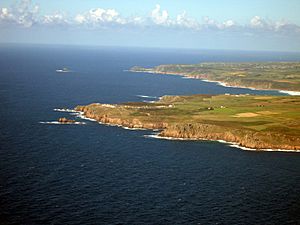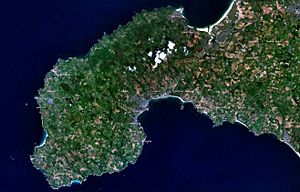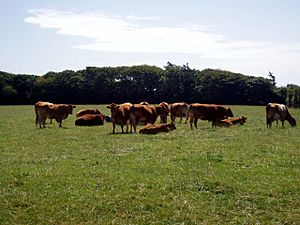Penwith facts for kids
| Penwith District | |
| Motto: Kensa ha Dewetha | |
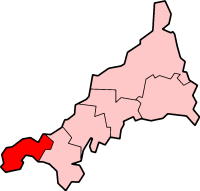 |
|
| Geography | |
| Status | Former district |
| HQ | Penzance |
| ONS code | 15UF |
| History | |
| Origin | *Borough of Penzance |
| Created | 1 April 1974 |
| Abolished | 1 April 2009 |
| Succeeded by | Cornwall unitary authority |
Quick facts for kids Demography |
|
|---|---|
| 1973 population | 51,690 |
| 2001 population | 62,994 |
| Politics | |
| Governance | District council |
 |
|
| Subdivisions | |
| Type | Civil parishes |
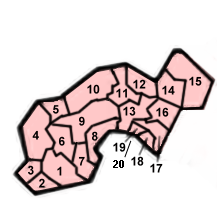 |
|
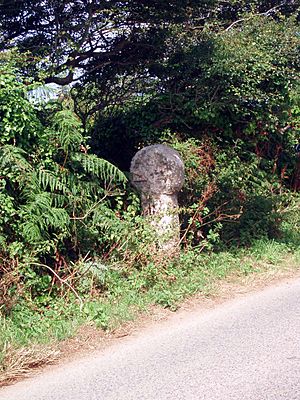
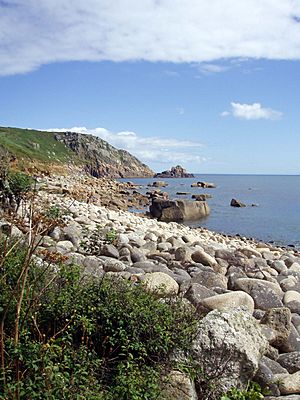
Penwith (/ˌpɛnˈwɪθ/; Cornish: Pennwydh) is a special area in Cornwall, England. It is located on a piece of land that sticks out into the sea, also called a peninsula. The name Penwith comes from two Cornish words. Penn means 'headland' (a point of land) and wydh means 'at the end'.
Penwith was also the name of a local government area. Its main office was in Penzance. This area is sometimes called West Penwith or the Land's End Peninsula.
Contents
Geography of Penwith
The Penwith peninsula is mostly made of a hard rock called granite. This rock has created a rugged coastline with many beautiful beaches. You can see where the granite meets other rocks at Land's End. This is the most western point in the area.
Mining History in Penwith
The geology of Penwith led to a lot of mining. People have mined for tin and copper here since before Roman times. You can still see ruined mine buildings scattered across the landscape.
Landscape and Climate
Inland, Penwith is mainly granite with thin soil. Because Cornwall is exposed to weather from the Atlantic Ocean, much of the area is a flat plateau. It stands about 130 meters (426 feet) above sea level. The highest point is Watch Croft, which is 252 meters (827 feet) high.
Some deep valleys, like Lamorna on the south coast, offer shelter from the wind. Trees can grow well in these valleys. Penwith has unique plants that are not found anywhere else in the UK. For example, Penzance's Morrab Gardens can even grow bananas!
Penwith also has an artificial lake called Drift Reservoir. It is about 3 miles west of Penzance. The coastline of Penwith is a Heritage Coast. West Penwith is also known as an Environmentally Sensitive Area. This means it is a special place for nature.
Towns and Villages in Penwith
The main towns in Penwith are Penzance and St Ives. Penzance is a port town and was the center for local government. St Ives is a very popular seaside resort.
The area is mostly rural, with many villages. Some of these include Botallack, Carbis Bay, Crowlas, Drift, Gulval, Hayle, Lamorna, Lelant, Long Rock, Ludgvan, Madron, Marazion, Morvah, Mousehole, Nancledra, Newlyn, Paul, Penberth, Pendeen, Porthcurno, Sancreed, Sennen, St Buryan, St Erth, St Hilary, St Just in Penwith, Treen and Zennor.
Transport in Penwith
Penwith is a bit isolated because it's at the very tip of Cornwall. Two main transport routes end here: the A30 road and the Great Western Main Line railway. The St Ives Bay Line connects St Ives to the main railway line at St Erth. A ferry to the Isles of Scilly also leaves from Penzance.
History of Penwith
Penwith has many ancient remains from the Bronze Age, Iron Age, and Celtic British times. These show that people have lived here for a very long time.
The Cornish Language
Penwith is believed to be the last place in Cornwall where the Cornish language was spoken by many people. Dolly Pentreath, who lived in Paul, is known as the last recorded speaker of Cornish. She died in 1777.
After Dolly died, a fisherman named William Bodinar from Mousehole wrote a letter saying he knew five other people in his village who could speak Cornish. This shows the language was still around.
People of Penwith
In 2007, Penwith had about 65,000 people living there. Most residents (96.4%) were born in the UK.
About 72% of people in Penwith said they were Christian. Nearly 18% said they had no religion. This is a bit higher than the national average.
Penwith has a lower rate of home ownership compared to other areas in England. It also has a lower percentage of homes with central heating. The area has a lower rate of people owning a second car.
The district has some health challenges. It also has a higher unemployment rate than many other areas. The number of people with a university degree is lower than the national average. Penwith also has a larger number of retired people.
Economy of Penwith
Penwith faces some economic challenges. It is considered one of the more deprived areas in England. This means it has fewer job opportunities and lower incomes for many people.
Many young, talented people leave the area after school. This is because there are not enough good job opportunities. Traditionally, Penwith's economy relied on mining and fishing. These industries have declined, which has affected the area. Tourism has helped create jobs, but many are seasonal or part-time.
Mining in Penwith
Tin mining was once very important in Penwith. Mines like Levant, Botallack, and Geevor were active. Over time, it became harder and more expensive to mine tin here. The industry eventually stopped in 1985.
Geevor was one of the last working tin mines in Cornwall. It is now a heritage site and museum. The closure of the mines greatly affected towns like St. Just and Pendeen. Many miners from Penwith moved to other countries to find work.
Fishing in Penwith
Fishing is still an important part of Penwith's economy. Newlyn harbour is a major fishing port in England. It lands a lot of valuable fish each year. The fishing boats are usually small and owned by their captains.
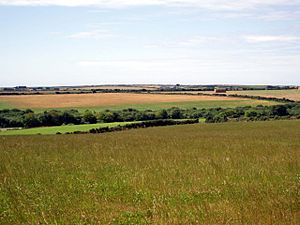
In the past, pilchards were a main catch. These fish are now sold as Cornish sardines. This has helped the fishing industry grow again. Much of the fish caught here is sold to countries like Spain and Italy.
Farming in Penwith
Farmers in Penwith have faced financial difficulties in recent years. Farming here is mostly dairy, with some crops like potatoes, cauliflower, and broccoli. Cornwall's mild climate means these crops can be grown earlier than in other parts of the UK. Early Cornish new potatoes are a valuable crop.
A special center called the Farm Business Centre was set up in 2002. It helps farmers in Penwith. It gives advice and funding to help them find new ways to earn money. This includes growing organic produce or raising rare animals.
Tourism in Penwith
Penwith's beautiful scenery makes it a popular place for holidays. Places like the Minack Theatre, South West Coast Path, Land's End, and Sennen Cove attract many visitors. St. Ives is also a popular place to celebrate New Year's Eve.
Penwith has many ancient sites from the Neolithic period. These include The Merry Maidens, Lanyon Quoit, Chûn Quoit, and the Iron Age village at Chysauster. Tourism is a big part of Cornwall's economy. Many families in Penwith earn money from tourism.
Media in Penwith
Penwith has its own weekly newspaper called The Cornishman. It has been published since 1878 and covers Penwith and the Isles of Scilly.
The area also has a local radio station called Coast FM. It started broadcasting in 2016.
Penwith District Council
The Penwith District was created on April 1, 1974. It brought together several smaller local government areas. These included Penzance, St. Ives, St Just, and the West Penwith Rural District.
On March 31, 2009, the Penwith District Council was ended. It was replaced by the larger Cornwall Unitary Council.
After 1974, towns like St Ives, Hayle, Marazion, and St Just gained their own Town Councils. These councils elected their own Town Mayors. Penzance also eventually created its own Town Council in 1980.
For many years, the Penwith District Council was run by independent members. These were people who did not belong to a political party. Later, political parties became more involved. The Conservative Party was often the largest group.
Twinning
From 1974 until it was abolished, the district of Penwith was twinned with:
 Cuxhaven, Germany.
Cuxhaven, Germany.
Places of Interest in Penwith
- Barbara Hepworth Museum
- Carn Euny
- Castle An Dinas

- Chûn Castle

- Chûn Quoit

- Chysauster Ancient Village

- Geevor Tin Mine
- Godrevy Island

- Land's End

- Lanyon Quoit

- Logan Rock
- Mên-an-Tol

- The Merry Maidens

- Minack Theatre
- Mousehole
- Mousehole Wild Bird Hospital and Sanctuary
- Newlyn Art Gallery
- Paradise Park, Cornwall
- Penlee House

- Museum of Submarine Telegraphy

- South West Coast Path
- St Michael's Mount

- Tate St. Ives
- The Wayside Folk Museum

- Zennor Quoit
See also
- West Penwith Rural District
- Beaches of Penwith
- Penwith hundred


